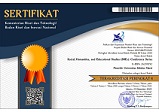The Role of Spatial Visual Intelligence in the Problem Solving Process of Building Spatial Geometry
Abstract
Visual-spatial intelligence plays an important role in elementary students' geometry problem-solving abilities, but limited research examines how different levels of spatial intelligence affect cognitive strategies in three-dimensional geometry tasks. This study aims to describe the patterns of cognitive strategies used by students with different levels of spatial intelligence and identify specific visualization difficulties encountered during geometry problem solving. This descriptive qualitative research involved in-depth interviews and classroom observations of three fifth-grade students of SDN Karanganyar 03 who were purposively selected based on the categories of high, medium, and low spatial intelligence, with data analyzed using the Miles and Huberman interactive model supported by thematic coding and triangulation techniques. Results showed students with high spatial intelligence demonstrated structured and reflective problem-solving patterns involving mental imagery, sketching, and systematic reasoning, while medium- and low-level students relied on external models or procedural calculations with minimal spatial representation. Students with low spatial capacity often face difficulties with mental rotation, shape manipulation, and visual ambiguity in three-dimensional geometry assignments. This research provides empirical insights into the dynamics of spatial processing in young learners, offering pedagogical implications for improving geometry learning at the elementary school level.
Keywords
Full Text:
PDFRefbacks
- There are currently no refbacks.





